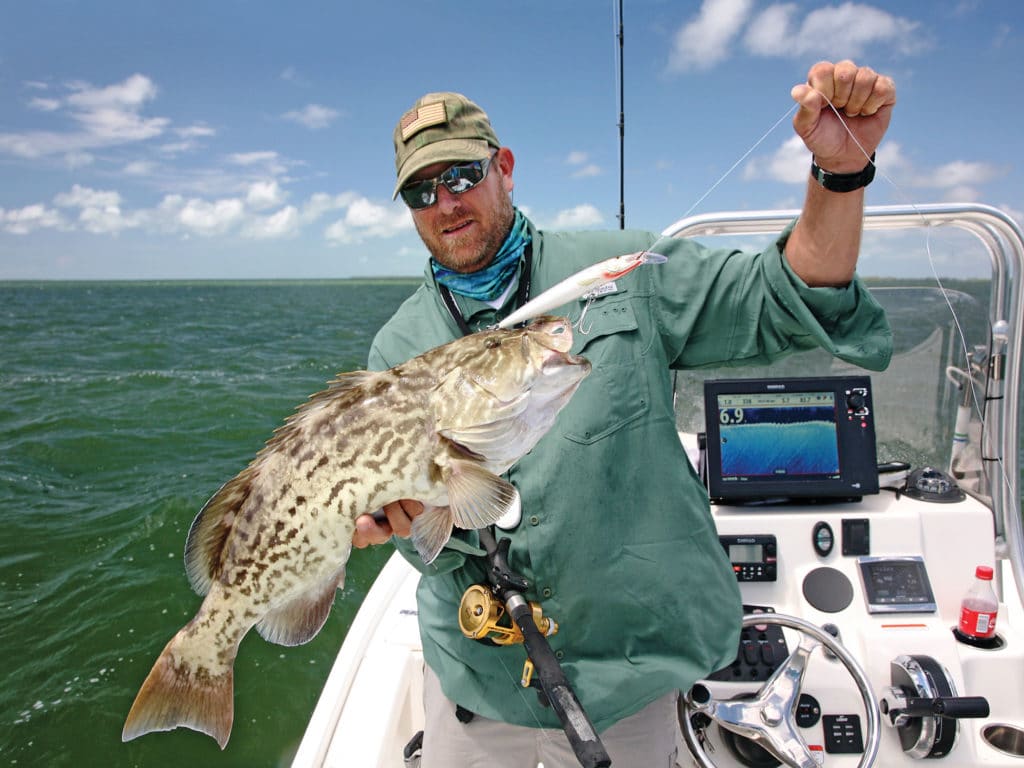
Inshore Prize
“Something nailed the lure but missed the hooks! “exclaimed Capt. George Clark Jr. “Did it feel like a grouper?” I asked. My cohort’s reply was an unexpected “Hooked up!” We were trolling big swimming plugs through Key Largo’s Barnes and Card sounds, experimenting with an alternative to the live baiting Clark does here for gag grouper. Within 10 minutes, we discovered that dragging diving plugs is deadly in these waters too.
While my boat continued forward slowly, Clark kept the grouper from powering back to its lair. Minutes later, he lifted a husky gag into the boat. We devoted another hour to trolling, losing all but the head of the next grouper to an aggressive shark, and another when the line parted on the channel edge after we were forced to avoid a collision with a large yacht that totally ignored our small boat. One thing is for sure: This area isn’t boring.
Inshore Fishing in Key Largo
I’ve fished with Clark and other notable Key Largo backcountry pros, like Capt. Tony Delos Santos, on several occasions. Both Clark and Delos Santos frequently travel deep into Florida Bay, often to far Gulfside Key Largo fishing spots, yet neither has any trouble bending rods with quality fish around Key Largo proper. Granted, it’s a scenic cruise into the Everglades, but why travel 35 to 50 miles each way when you usually do just as well or better closer to home, with a stop for lunch at Sundowners Key Largo or the famous Alabama Jacks?
Key Largo fishing is known for yielding large numbers of small trout, most under a pound. However, several years ago I learned that big ones thrive here too. During a trip with Delos Santos, I netted a 5-pounder for him while drifting live pilchards back with the tide into a creek. He explained the big trout gather in the creeks for their spring spawn. “Last year, the spawn was in Jewfish Creek, this year in Trout Creek,” Delos Santos said. “I look for structure in the creeks and other spots where baitfish move in and out. Dirty water is good too; it makes it easier to fool bigger fish,” he explained.
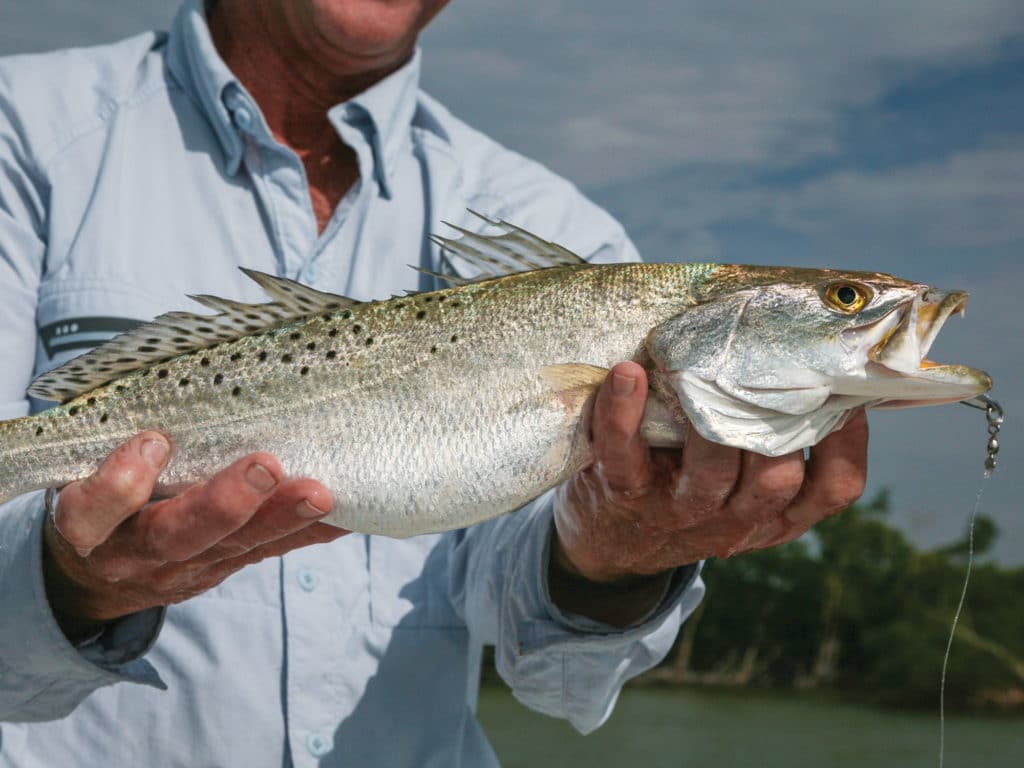
Fish Live Bait or Artificials in Key Largo
With minimal tide movement, Delos Santos freelines live pilchards and mojarras in these creeks, adding a split shot as the tide picks up, and often culminating with a knocker rig at full flow. He prefers 20-pound fluorocarbon leader in clear water and 30-pound in cloudy water, with 1/0 to 3/0 in-line, light-wire circle hooks, based on the size of the bait.
“One good trick: If the bite on the free-lined baits ceases, switch to a popping-cork rig,” Delos Santos says. “I set the float to hold the bait halfway to the bottom. That and the popping noise of the cork usually get the trout going again. When that slows, we go back to free-lining.”
In the shallows, school trout forage along seagrasses and in sand holes. They devour live pilchards, finger mullet and small pinfish, either free-lined or suspended beneath a popping/rattle float, but artificials are also productive. Topwater plugs are best early in the morning, and swimming plugs keep the bite going as the sun rises higher.
Soft-plastic grubs, shrimp and baitfish imitations are also consistent. “Look for muds around islands and over grasses. Those are feeding trout,” Delos Santos says. “Shut the outboard and use a trolling motor to ease into casting range. If they’re not aware of the boat, you can catch a bunch.”
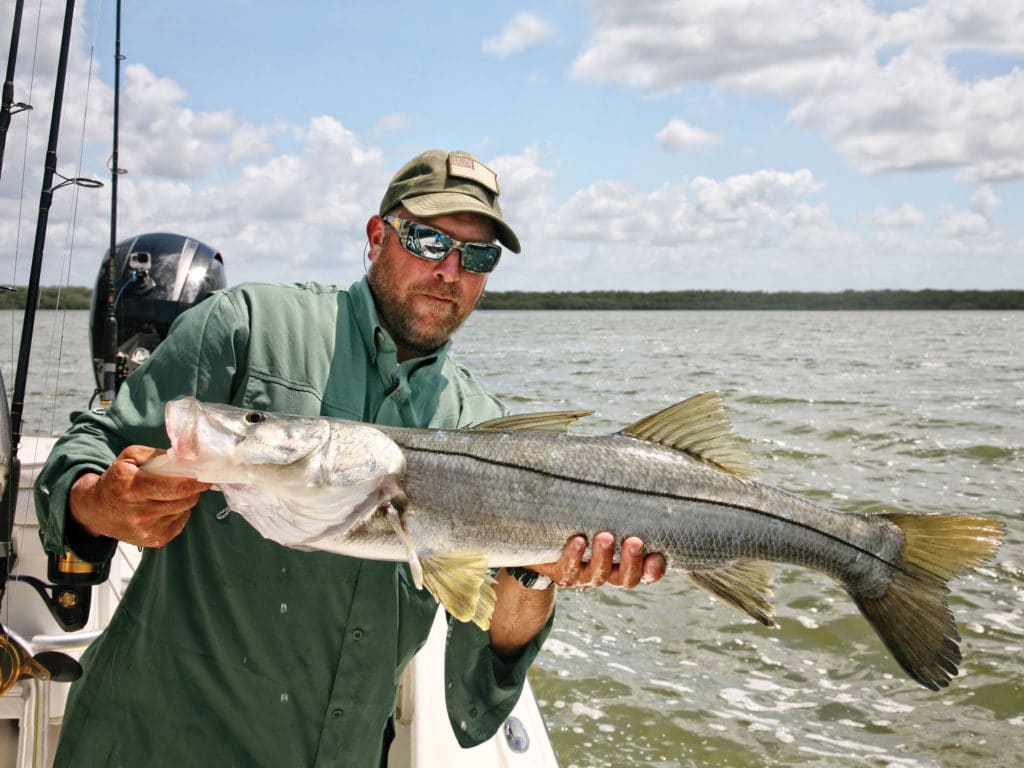
Snook Fishing in Key Largo
The network of islands and creeks behind Key Largo and extending through its northernmost sounds holds plenty of snook. “At times, I catch snook just 3 miles from my dock,” Clark says. “From summer through fall, before the cold fronts arrive, snook hang around anything that flows into the ICW. I often hit creeks feeding off Joe Bay, like Trout and Mud, as well as those around Long Sound. But Key Largo is practically surrounded by good snook spots.”
Clark recommends free-lining a live pilchard or finger mullet on a spin outfit with 20-pound braid, 40-pound fluorocarbon leader and an in-line circle hook for snook, focusing on narrow passages, troughs and deep undercut mangroves.
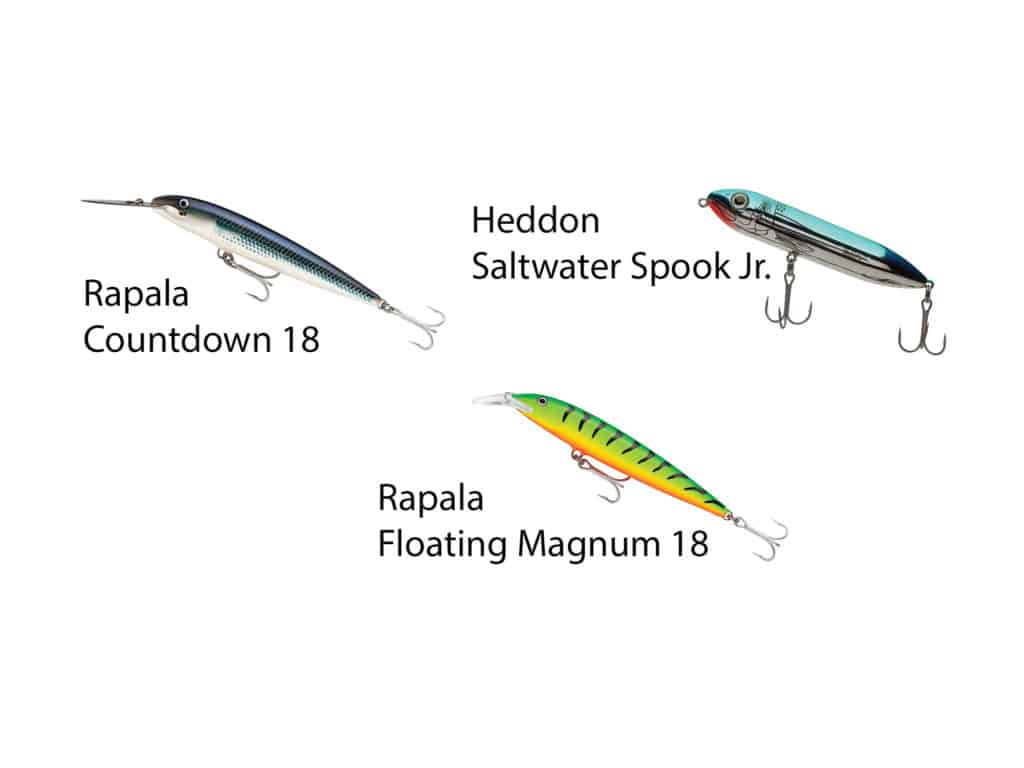
Though not practiced as often, plug-trolling remains another deadly tactic to catch snook here after sundown in specific Key Largo fishing spots. Jewfish Creek offers a good trolling spot, and the Marvin D. Adams Waterway is another. Deep-diving plugs, such as Rapala’s Countdown 18, get the nod in deeper channels and around deeper, lighted bridges, while short-lipped, shallow-running plugs, like the Floating Magnum 18, perform best along lighted docks and shallower channels.
Rig trolling plugs with 60-pound fluorocarbon leaders. As when trolling for grouper, drop the plug back until it bumps bottom, then reel up a few cranks. Hold the rod downward (tip pointed at the water), watch the sonar for obstructions that may require lifting the plug, and troll along the deep sides of channels, past bridge groins and channel mouths. Between snook strikes, expect encounters with jack crevalle, tarpon and, perhaps, gag grouper.
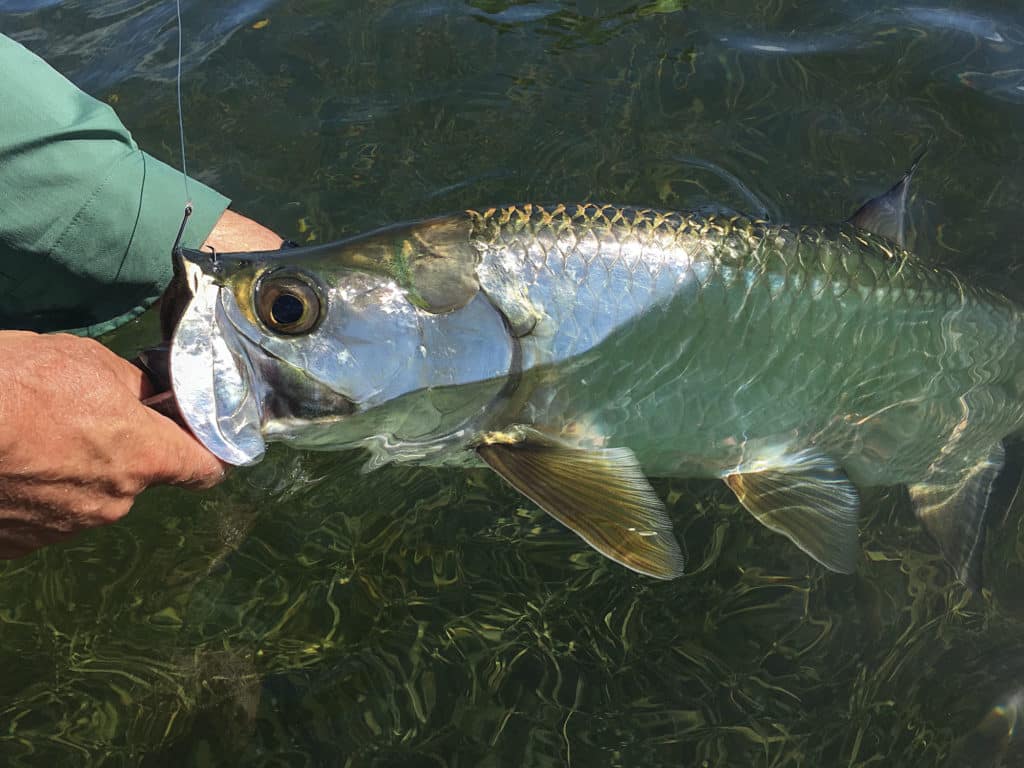
Key Largo Tarpon Fishing
Tarpon abound in March and April, especially along oceanside flats, with some bigger ones lingering around the bridges a bit after that. A brief but sometimes explosive second tarpon run materializes between September and October with the finger mullet migration. The shallows and mangrove islands throughout Barnes and Card sounds, and well north to Caesar Creek and Elliott Key, also hold fair concentrations of juvenile tarpon.
On one tarpon fishing outing with Clark, we spotted three juvenile tarpon milling tight to a mangrove island on a high tide. Clark pitched a live pilchard three times before he found a player and was rewarded by a gallant, acrobatic fight in less than 3 feet of water. The same tackle and tarpon baits, including soft plastics outlined for snook, are ideal for smaller tarpon. For large fish, step up to a heavier 20- or 30-pound-class outfit, 80-pound fluorocarbon leader and a 6/0 in-line circle hook, baited with a live crab, large pilchard, mullet or pinfish.
Fishing for Key Largo Redfish
As summer transitions into fall, August, September and October specifically, inshore fishing in Key Largo heats up. Redfish cruise the flats and mangrove shorelines, becoming great sight-fishing targets. Some of the very points that hold snook (such as creek mouths and bends, submerged structure and deep undercut mangroves) also hold redfish when water temperatures drop. Even better, the same tackle works on reds; just make sure the baits remain near the bottom during cooler weather.
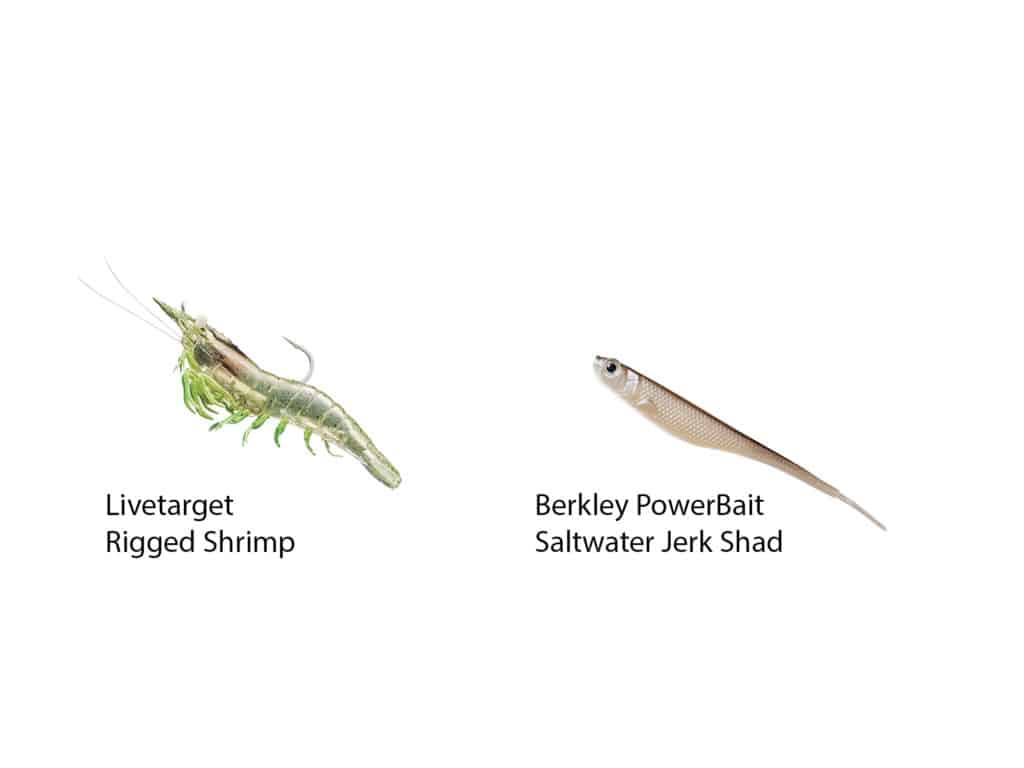
Fishing in Key Largo for Grouper
Concentrations of gag grouper move inshore during the cooler months, especially during February and March. Not unlike snook, they favor deeply channeled mangrove networks with good tidal flow, and they readily take live pilchards and pinfish pitched underneath. If you don’t snag mangroves occasionally, you’re not fishing tight enough. Delos Santos has a solid handle on catching skinny-water gags.
We scored a number of grouper approaching 10 pounds with stout tackle, braided lines, leaders no lighter than 50-pound-test, and 2X Strong, 3/0 in-line circle hooks. Basically, either you muscle a grouper out of the mangroves with a nearly locked-down drag, or it’ll break you off in the roots.
As mentioned earlier, when the gags are in, they also frequent deeper channels and passages, where live-baiting and trolled swimming plugs do the trick. Look for uneven or protruding edges along the deep side of a channel, with small ledges, depressions or scattered rocks along the bottom, all of which offer prime ambush stations for grouper.
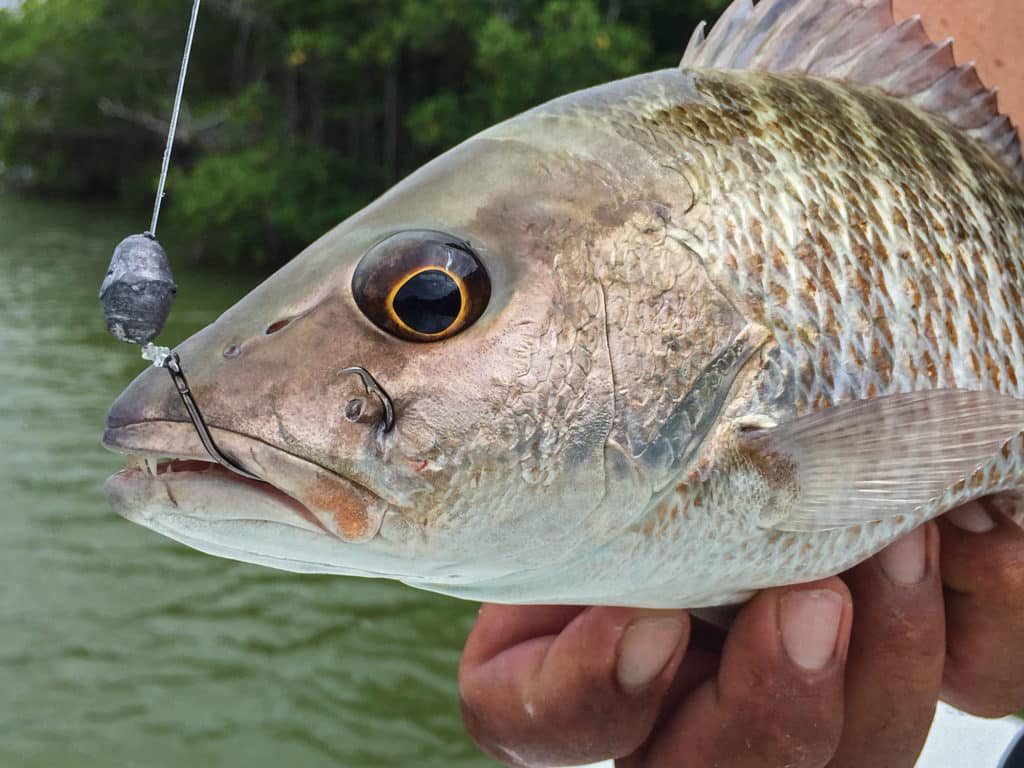
Other Key Largo Fishing Targets
Count on mangrove snapper and jack crevalle to intercept live baits at any given time. Delos Santos often targets mangrove snapper, an endeavor for which he prefers creeks with good water flow and marginal clarity. “We catch plenty of mangroves in that 11- to 17-inch range,” he says.
“My favorite bait, though they don’t last long, is a small, live mojarra. They are shiny, can’t outrun a mangrove, and just get devoured. As odd as it may seem, this past year we’ve been doing very well using frozen shrimp. Again, go light to fool these keen-eyed fish; for best results, drop back to 20-pound-test leader and a 1/0 light-wire circle hook.”
Jacks pushing 10 pounds are possible year-round, but 20- to 30-pounders show up during the spring. Clark says the big boys mostly traverse the ICW, the Jewfish Creek and Card Sound bridges, and Angelfish and Broad creeks. They’re easily chummed into a frenzy with live pilchards and will annihilate a live bait or topwater plug cast their way.
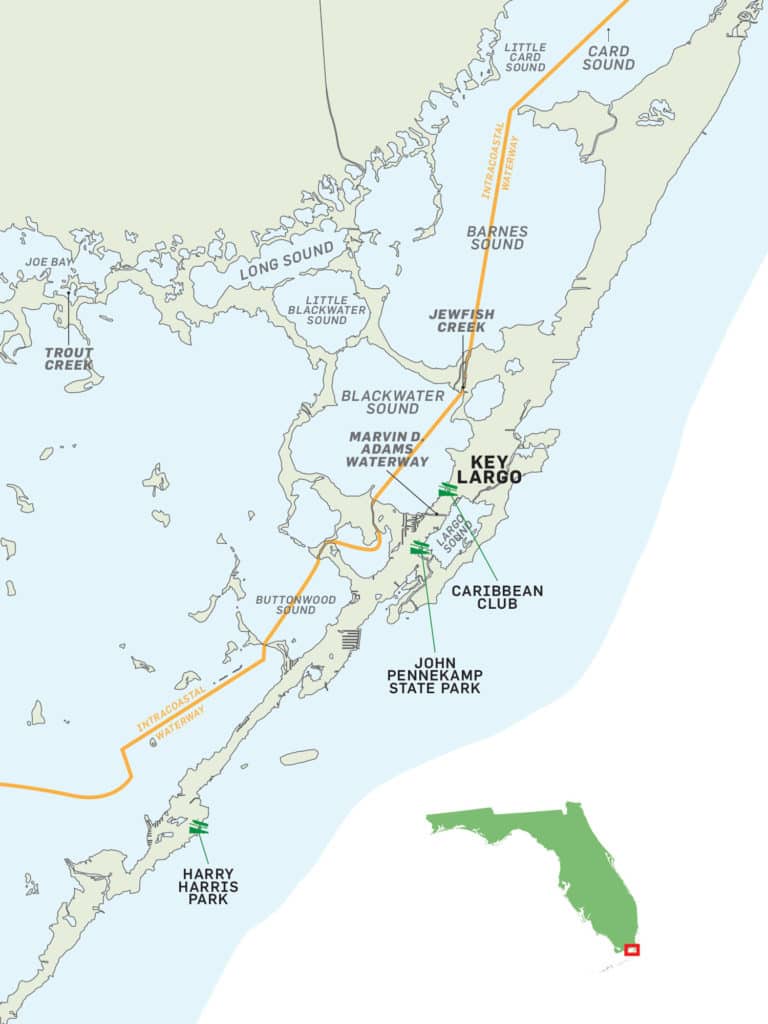
Key Largo Lodging
- Hotels Ocean Pointe Suites Located on Key Largo’s Atlantic side at mile marker 92.5, is an angler-friendly, condo rental establishment complete with a boat ramp, dockage and even parking for trailers.
- Marriott Resort Key Largo Bay is another great place to stay when fishing the upper Keys. It’s located bayside at mile marker 103, and features a marina, spa and numerous other amenities.
- Here are three top places to launch in Key Largo: Harry Harris Park, Caribbean Club and John Pennekamp State Park.
Key Largo Fishing Captains
- Capt. Tony DelosSantos, 305-522-4724, lyinhawaiian.com
- Capt. George Clark Jr., 305-522-2638, rodeocharters.com
- Capt. Lain Goodwin, 305-304-2212, dirtywaterscharters.com
Key Largo Fishing Tackle
Rods: 7-foot spinning for 30- to 50-pound line; stout 61⁄2-foot conventional rated for 50- to 80-pound for trolling, live-baiting or dead baits
Reels: 4000- to 4500-class spinning for lures and small live baits; star or lever drags rated for 30- to 50-pound for trolling and big baits
Line: 20-pound braid for casting and pitching; 50-pound braid for big baits and trolling plugs
Leader: 20- to 30-pound fluorocarbon for seatrout and mangrove snapper; 40-pound for snook and small tarpon; 60- to 80-pound for grouper and large tarpon
Hooks: In-line circle hooks, 1/0 to 6/0, matched to the bait and species; 2X Strong for grouper and large tarpon
Baits: Live pilchards, mullet, pinfish and mojarras; dead shrimp for seatrout and mangrove snapper
Lures: Topwater plugs, swimming plugs and soft plastics; Rapala Countdown 18 for trolling channels and bridges, Floating Magnum 18 for shallower channels and lighted docks









